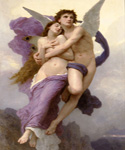 The high pitched whine from the chopper blades droned out the constant chatter coming from the radio. Charli sat staring out the small window almost in a trance.
The high pitched whine from the chopper blades droned out the constant chatter coming from the radio. Charli sat staring out the small window almost in a trance.What a contrast this beautiful Alaskan landscape was after her tour in the desert. As she looked out at the endless sea of whiteness, her mind began to flash back..... A mirage of orange sand stared at her now, with its endless peaks and beautiful ridges. The warm afternoon sun beaming through the open door of the chopper as they flew back to base on daily patrol. The high wind was causing a lot of turbulence, and brought her back to reality as they prepared to approach the frigid cold crash site. She was beginning to feel the familiar nausea that accompanied every flight. Always a little leery of what she would find when they got on scene.
The dispatcher had radioed that the last communication from the cockpit of the downed plane was from a small boy, approximately nine years of age. His father was piloting a twin engine Cessna 320E, with his mother and sister on board. After an apparent loss of one engine, and altitude, their aircraft went down. Her heart bled for this family as they approached them. Using their GPS, maps of the area, as well as the most advanced computer technology available, they should be easy to locate. Their last known coordinates had put them in the midst of a dense section of the forest.
Hovering the chopper was out of the question. The high winds and turbulence were going to make this an extremely difficult mission. They would have to insert in through the trees. Considering that the aircraft had crashed over four hours ago, they didn’t have much time.
Charli was accustomed to engaging the enemy, but the merciless enemy they were up against this day was the weather. The wind was howling and the snow was turning from flakes to an impenetrable slush, and they were ready for battle.
There was an eerier silence among them. You could feel the tension in the air as they prepared themselves mentally for the worst. There was a break in the chatter on the communication system in Charli’s helmet that had been non-stop since they took off.
“Okay team, we have located the wreckage. Prepare for insertion. You boys are gonna need your tree suits for sure. This is going to be a rough ride down…..copy?”
“Copy that Nash."
The two men put on the cumbersome tree suits. These suits were bulky, with extra padding on the knees, elbows, and special protection for the neck, but were vital to keeping them safe in these kinds of jumps.
The two men put on the cumbersome tree suits. These suits were bulky, with extra padding on the knees, elbows, and special protection for the neck, but were vital to keeping them safe in these kinds of jumps.
Noah was going down first.
Charli was in position, she opened the chopper door, and was on standby, ready to operate the wench that would lower the men down to the scene waiting for them below. Noah hadn’t spoken two words to Charli since that first day in the hanger. She had always made an effort to give him space, she knew he would make peace with her when he was ready.
Noah made his way to the open door. Once his harness was secure, he gave Charli thumbs up, and their eyes met. For that second…..time stood still.
Charli could not stop herself, with no thought of consequence she looked deep within him. His eyes were truly the window to his soul. Immediately she wished she hadn’t looked. Years of hurt and torment gazed back at her, stabbing her heart through with a dagger of regret. She looked away, and swallowed hard. The pain that I have inflicted upon this man because of my selfish stupidity…..I am such an asshole, she thought to herself.
He stepped to the edge of the chopper, and began to lower himself slowly into the vast wall of trees beneath him.





